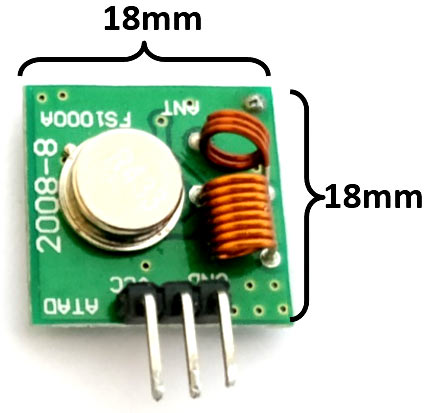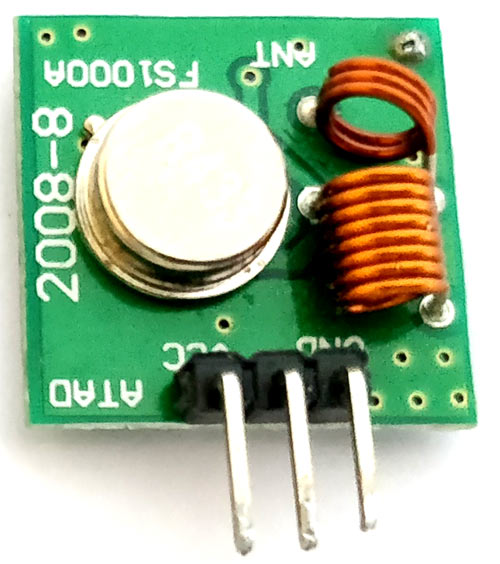FS1000A 433 MHz RF Transmitter Module
FS1000A RF Module Pinout Configuration:
|
No: |
Pin Name |
Description |
|
1 |
Vcc |
Power supply (+5V only) |
|
2 |
Data |
Data to be transmitted is sent to this pin |
|
3 |
Ground |
Connected to the ground of the circuit |
|
4 |
Antenna |
Solder wire/antenna to improve range (not mandatory) |
FS1000A 433 MHz Module Specifications:
- Wireless (RF) Simplex Transmitter and Receiver
- Transmitter Operating Voltage: +5V only
- Transmitter Operating current: 9mA to 40mA
- Operating frequency: 433 MHz
- Transmission Distance: 3 meters (without antenna) to 100 meters (maximum)
- Modulating Technique: ASK (Amplitude shift keying)
- Data Transmission speed: 10Kbps
- Circuit type: Saw resonator
- Low cost and small package
Note: The FS1000A RF module datasheet can be found at the bottom of the page
Other RF Modules:
HC12, nRF24l01, nRF905
Other Wireless options:
Bluetooth, Lora, ESP8266, GSM, Xbee
Where to use FS1000A 433 MHz RF Modules:
The FS1000A 433MHz wireless module is one of the cheap and easy to use modules for all wireless projects. These modules can be used only in pairs and only simplex communication is possible. Meaning the transmitter can only transmit information and the receiver can only receive it, so you can only send data from point A to B and not from B to A.
The module could cover a minimum of 3 meters and with proper antenna and power supplies it can reach upto 100 meters theoretically. But practically we can hardly get about 30-35 meters in a normal test conditions.
So if you are looking for a simple wireless communication to transmit information within a short distance, then these RF pair could be the right choice.
How to use FS1000A 433MHz RF Modules:
The module itself cannot work on its own as it required some kind of encoding before being transmitter and decoding after being received; so it has to be used with an encoder or decoder IC or with any microcontroller on both ends. The simplest way to use it is with the HT12E Encoder and HT12D Decoder IC.
The module uses ASK (Amplitude shift keying) and hence it’s easy to interface with microcontrollers as well. If you are trying to use this with Arduino, then the Radiohead library would make things easy for you. However you cannot expect noiseless data for a long distance form this module as this is very much susceptible to noise. The rage depends on the voltage supplied to Receiver and the noise present in the environment.
Applications:
- Home automation
- Transmit Serial data for short distance
- Car security system
- Wireless logging
- Short distance communication
Dimension of the Module:












